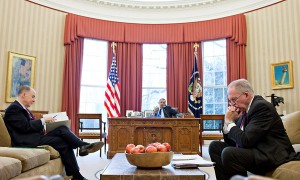The Terror Attack in the Temple
Over at Lawfare yesterday, a Sikh Notre Dame professor, Naunihal Singh, argued that the media have treated the Oak Creek attack as a singularly Sikh tragedy, not an American one.
The media has treated the shootings in Oak Creek very differently from those that happened just two weeks earlier in Aurora. Only one network sent an anchor to report live from Oak Creek, and none of the networks gave the murders in Wisconsin the kind of extensive coverage that the Colorado shootings received. The print media also quickly lost interest, with the story slipping from the front page of the New York Times after Tuesday. If you get all your news from “The Daily Show” and “The Colbert Report,” you would have had no idea that anything had even happened on August 5th at all.
The tragic events in the Milwaukee suburb were also treated differently by political élites, many fewer of whom issued statements on the matter. While both Presidential candidates at least made public comments, neither visited, nor did they suspend campaigning in the state even for one day, as they did in Colorado. In fact, both candidates were in the vicinity this weekend and failed to appear. Obama hugged his children a little tighter after Aurora, but his remarks after Oak Creek referred to Sikhs as members of the “broader American family,” like some distant relatives. Romney unsurprisingly gaffed, referring on Tuesday to “the people who lost their lives at that sheik temple.” Because the shooting happened in Paul Ryan’s district, the Romney campaign delayed announcement of its Vice-Presidential choice until after Ryan could attend the funerals for the victims, but he did not speak at the service and has said surprisingly little about the incident.
As a result, the massacre in Oak Creek is treated as a tragedy for Sikhs in America rather than a tragedy for all Americans. Unlike Aurora, which prompted nationwide mourning, Oak Creek has had such a limited impact that a number of people walking by the New York City vigil for the dead on Wednesday were confused, some never having heard of the killings in the first place.
I absolutely agree with his assessment of media attention, and I agree that the differential attention stems from real discomfort (which is a polite word for ignorance, maybe) about Sikhism. It was all the media could do to explain that Sikhs weren’t Muslim, by which I actually think they meant well, but which betrayed horrible things about their views both of Muslims and turbans.
But I don’t agree, exactly, that politicians stayed away (or didn’t publicize their attendance at the memorial, in the case of Ryan) because of their unfamiliarity with Sikhs. I don’t think any of the Presidential and Veep candidates are as unfamiliar with Sikhs as the media are, for example.
Rather, I think it has to do with the political role of terrorism.

